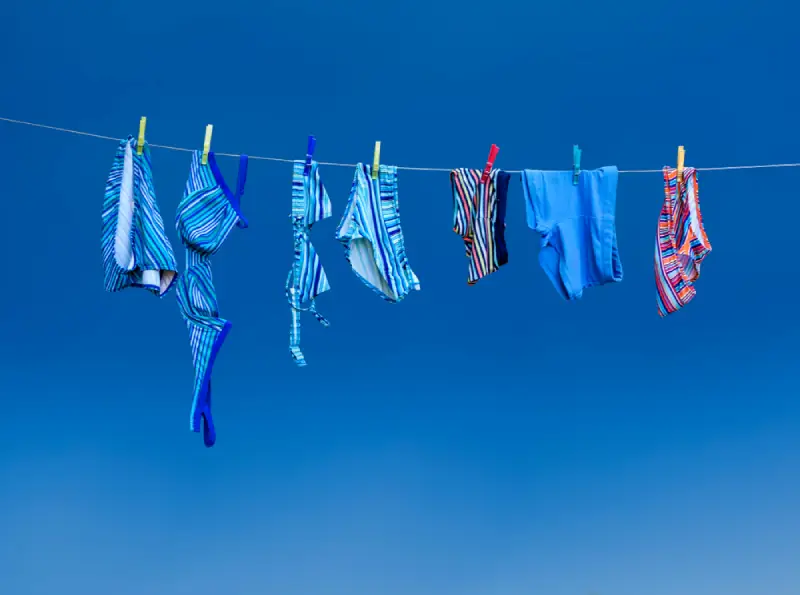
Molly Maid offers these expert tips for removing chlorine from swimsuits, hair, and skin after swimming.
|
There’s nothing like a refreshing dip in the pool—until you catch a whiff of that persistent chlorine smell clinging to your skin, your hair turns green, or your favorite swimsuit starts to lose its luster. Whether you're a daily swimmer, a vacation pool-hopper, or just taking the kids for a splash, chlorine has a sneaky way of overstaying its welcome. From dry, itchy skin to brittle hair and faded swimwear, the post-pool struggle is real.
Let’s break down how to clean that chlorine for good so you can enjoy pool days without the lingering effects.
Why Is Chlorine So Tough to Wash Off?
Chlorine is a powerful chemical that kills bacteria and keeps pools sanitary. But that strength comes with some trade-offs.
Chlorine molecules:
- Bind to proteins in your hair and skin.
- Damage fabric fibers over time.
- Are notoriously hard to rinse away with water alone.
That means cleaning up after a dip takes more than rinsing with fresh water. You’ll need to neutralize the chlorine entirely.
How to Remove Chlorine from Your Bathing Suit
Chlorine can ruin your new suit in a single summer if you let it. Keep those colors popping for many swim seasons to come with these tips:
- Rinse immediately after swimming. The moment you’re out of the pool, give your swimsuit a good rinse with cold, clean water. Don’t wait until you’re home—the longer chlorine sits, the more time it has to break down elastics and pigments.
- Hand wash with gentle detergent. Skip the washing machine. Instead, hand wash bathing suits with cold water and a gentle detergent specifically made for delicates. Better yet, use a detergent designed to remove chlorine from swimsuits, as this will neutralize chlorine instead of masking it.
- Use white vinegar for a deep clean. To really get the chlorine smell out of your suit, soak it in a mixture with one tablespoon of white vinegar per quart of cold water for 15–30 minutes. Vinegar is a mild and effective solution for breaking the chlorine bond.
- Air dry always. Never wring out or toss your suit in the dryer. Lay the bathing suit flat on a towel and reshape it before letting it dry naturally. Heat from the dryer can damage the elastic even further, so save your suits!
Want more advice for every type of fabric in your home? Check out our cleaning tips.
How to Remove Chlorine from Hair
Hair soaks up chlorine like a sponge, often resulting in dullness, breakage, and even a greenish tint if you’re blonde. If you’d like to enjoy the pool and your hair, follow these tips:
- Wet hair before swimming. Soaking your hair with clean water before getting in the pool means there’s less room for chlorine to sneak in. Think of it like priming your hair.
- Use a swim cap (yes, really). A swim cap might not be a fashion statement, but it’s an excellent defense for your hair. Choose a silicone swim cap over latex for better protection and significantly reduced chlorine exposure, especially for color-treated or fragile hair.
- Rinse and shampoo ASAP. As soon as you’re out of the pool, rinse your hair thoroughly with lukewarm water. Then, wash with a clarifying or swimmer-specific shampoo designed to remove chlorine from hair. These shampoos break the chemical bond that chlorine forms with your strands.
- Deep condition weekly. Chlorine strips natural oils, leaving hair dry and brittle. Replenish moisture with a deep-conditioning mask once a week. Look for ingredients like keratin, aloe vera, or argan oil for maximum hydration and repair.
- Skip the heat styling. On pool days, give your hair a break from heat tools. Chlorine and heat are a damaging combo. If you must style, use a heat protectant spray and go low and slow with your tools.
Pro Tip from Hairdressers: Saturate your hair in conditioner (it doesn’t have to be a fancy or expensive one) before you go swimming. Alternatively, apply a leave-in conditioner, hair mask, or coconut oil. The conditioner/mask will act as a barrier to protect against chlorine damage. Your hair will thank you!
How to Remove Chlorine from the Skin
Chlorine doesn’t just dry out your skin—it can trigger irritation, rashes, or an unpleasantly tight, papery feeling. But you don’t have to endure that persistent post-pool itch. Let’s talk about how to get rid of chlorine itch effectively.
- Take a lukewarm shower immediately. Use a gentle, moisturizing body wash and lukewarm water (never hot!) to wash off chlorine after swimming. Scrub gently, as harsh loofahs or exfoliants can further irritate your skin.
- Moisturize ASAP. After toweling off, apply a thick, fragrance-free moisturizer or body oil while your skin is still slightly damp. This locks in hydration and helps soothe irritation. Look for ingredients like ceramides, shea butter, hyaluronic acid, or oatmeal for calming effects.
- Add baking soda or oatmeal soaks. If your skin is red, dry, or itching like crazy, take a warm bath with a cup of baking soda or colloidal oatmeal. Both are known for their soothing and anti-inflammatory properties—and they work wonders to get rid of a chlorine itch quickly.
- Don’t skip sunscreen after. Chlorine can make skin more sensitive to the sun, increasing your risk of irritation or sunburn. If you’re heading back outside, always reapply sunscreen after pool time, especially after showering. Choose a mineral-based formula for sensitive post-swim skin.
- Hydrate from the inside out. Drink plenty of water throughout the day—hydration is key to helping your skin bounce back from chlorine exposure. Add hydrating snacks like cucumber, watermelon, or oranges to boost your glow.
How to Get Rid of Chlorine Stains on Clothes
If chlorine splashes beyond your suit—onto your cover-up, towels, or clothing—it can leave yellowish spots or an overpowering scent. Here’s what to do:
- Act fast: Rinse clothes right away with cold water.
- Treat stains: Use a color-safe bleach or oxygen-based cleaner for whites and lights.
- Soak to de-stink: To get the chlorine smell out of clothes, soak them in a solution of equal parts vinegar and water before washing. Add half a cup of baking soda to the rinse cycle for better results.
Pro Tip: Avoid using traditional bleach. It reacts with chlorine and may make things worse.
What NOT To Do When Removing Chlorine
When cleaning up after the pool, avoid these common mistakes:
- Don’t wash suits in hot water or the washing machine.
- Don’t let chlorine-drenched clothes sit for hours.
- Don’t skip hair conditioner post-swim.
This article is intended for general guidance only and is not applicable to every situation. You are responsible for determining the proper course of action for your property and situation. Molly Maid is not responsible for any damages that occur as a result of advice and/or guidance derived from its blog content. Molly Maid services may vary by location. For the most accurate guidance, contact the Molly Maid nearest you for more information and a professional on-site assessment.
Pool Days Without the Payback
Now that you know how to avoid the worst effects of chlorine, you’re ready to spend your summer soaking up the sun—so leave the housework to the professionals! Molly Maid® provides top-to-bottom cleaning services to help you enjoy a home that’s fresh, tidy, and guest-ready, all without lifting a finger. And with all services backed by the Neighborly Done Right Promise®, you can rest assured we’ll always leave your space cleaner than we found it.
Learn more about our services or request a free estimate today. Browse our locations to find the Molly Maid team near you!
FAQs About Removing Chlorine
Since 1984, Molly Maid has proudly provided a reliable, professional, and affordable solution to a messy, dirty home. Providing the house cleaning services that busy homeowners need also includes using our years of experience to answer your questions. Here are answers to some of the most frequently asked questions about how to remove chlorine from bathing suits, hair, and skin.
How do you remove chlorine from hair after swimming?
To remove chlorine from hair, rinse immediately with lukewarm water, then wash with a swimmer-specific or clarifying shampoo. Follow up with a deep conditioner to restore moisture and prevent breakage.
Why is skin itchy after swimming?
The most common cause of itching after using a swimming pool is chlorine on the skin. Prolonged exposure to chlorine can irritate and dry out skin, causing itching and, in some cases, even a red or bumpy rash.
To effectively remove chlorine from the skin and resolve the itchiness, shower with a gentle, moisturizing body wash and lukewarm water immediately after swimming. Avoid hot water! Follow the shower with a rich, fragrance-free moisturizer or body oil.
Does chlorine damage swimsuits?
Yes, prolonged exposure to chlorinated water (as in most swimming pools) will damage swimsuits over time. While you may have noticed the colors fading, chlorine can also weaken the fabric and degrade elastic elements. Over time, this can cause the suit to lose its shape and not fit as well.
To protect your suit from chlorine damage, rinse it immediately after swimming, then hand wash in cold water using a mild detergent designed to remove chlorine from swimsuits. Avoid wringing and always air dry flat to preserve elasticity.
How can I get the chlorine smell out of clothes and towels?
To remove that chlorine smell without damaging the fabric, soak clothes and towels in equal parts white vinegar and water (a bathtub or deep sink works great). Then, wash normally with ½ cup of baking soda for the rinse cycle. This neutralizes the odor and breaks down chlorine residues without harming fabrics.
Why is it important to neutralize chlorine instead of just rinsing it off?
Chlorine is a caustic substance that binds to hair, skin, and fabric fibers. Without the use of neutralizing agents like vinegar or specialty products, chlorine molecules remain active, leading to dryness, irritation, and potentially long-term damage.
